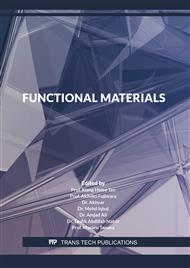p.177
p.185
p.197
p.205
p.213
p.221
p.227
p.233
p.239
Fracture Surface Analysis, Physical, Optical and Dielectric Properties of Bismuth-Based Glass Doped with Potassium Chromate
Abstract:
Bismuth glasses have been prepared from a commercial-grade chemical glass mixture doped with potassium chromate in different contents. They have been melted at 1250 °C for 4 h, quenched in a metal plate, and annealed at 500 °C for 20 min. The surface morphology of glass samples has been examined using scanning electron microscopy (SEM). The dielectric properties have been investigated. UV-Vis-NIR absorption has been analyzed. The results show the growth of microcrystal precipitated in the glass matrix, and colors of glass change from colorless to green and opaque with the increasing content of potassium chromate. The density of glass decreases with the increasing content of potassium chromate. The UV-Vis spectra show strong absorption of UV. The chromium-doped glasses not only absorb the UV but also the violet and/or blue lights which depend on the chromium contents.
Info:
Periodical:
Pages:
233-237
Citation:
Online since:
August 2022
Authors:
Price:
Сopyright:
© 2022 Trans Tech Publications Ltd. All Rights Reserved
Share:
Citation:



